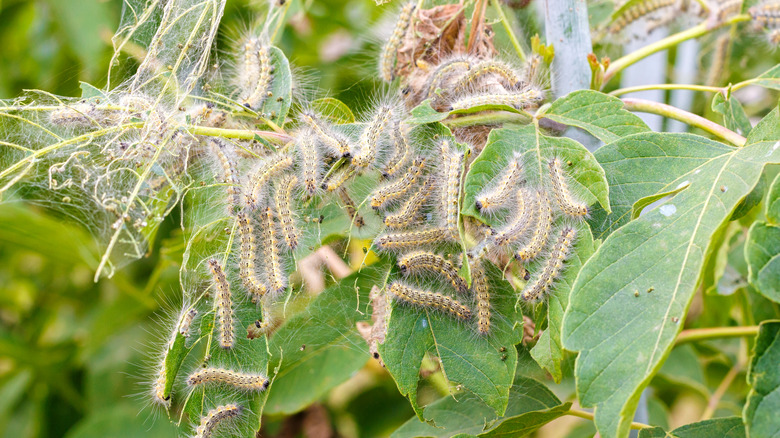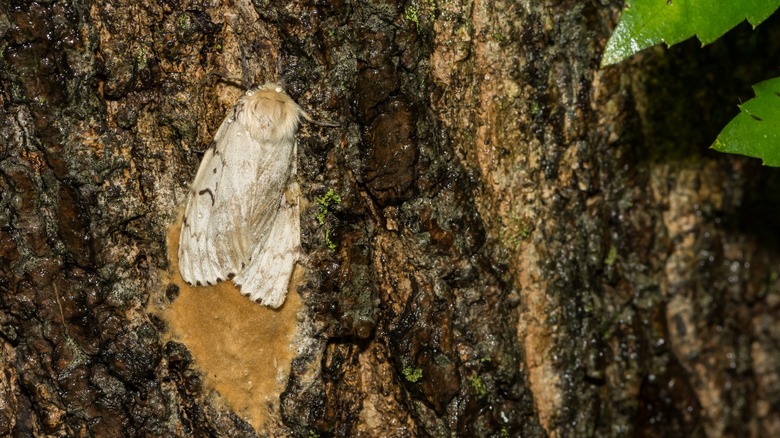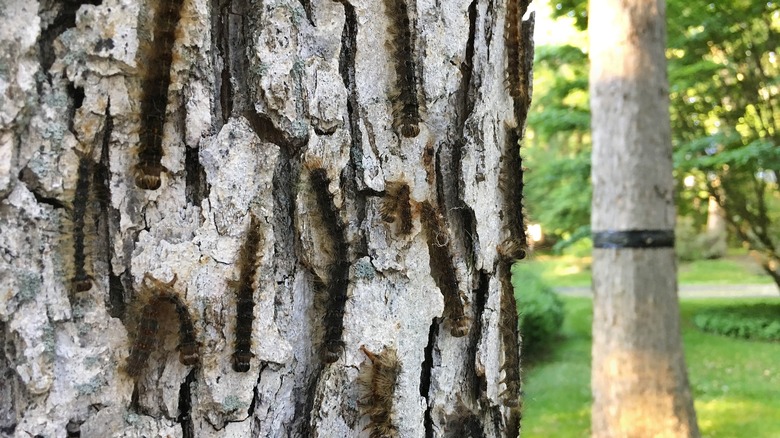How To Manage A Spongy Moth Infestation Before They Overtake Your Garden
The spongy moth (Lymantria dispar), formerly known as the gypsy moth, is an invasive moth that was brought to the U.S. from France in 1869 for silk production. It has been causing major damage to forests and backyards about every 10 years since. If you notice defoliation on your oak trees, one of the spongy moth's preferred plants, you should start looking for signs immediately. A spongy moth caterpillar outbreak can feel like it happens overnight. One mid-July morning, you wake up to find half of your favorite tree's leaves gone and a swarm of fuzzy caterpillars all over your yard. The tricky part is that signs of their presence can be seen the summer before, when the adult moths mate and lay egg masses. If you are keen enough to find and destroy the egg masses before they hatch, you can save yourself a lot of trouble.
To manage an infestation in your own yard, it is much easier to do when the caterpillars have come down from the canopy. Once they have hatched and reached maturity, they eat tree leaves at night and move down to rest during the day, where you may see them on your home, tree trunks, and vehicles. You can physically trap, remove, and destroy them. A chemical spray may be applied if done safely. Otherwise, you may need to call in professional help. Or, crazy as it may sound, in some cases you can sit back and let nature take its course.
How to manage a spongy moth infestation
The presence of spongy moths does not automatically equate to an infestation. Healthy trees can usually withstand minor defoliation once a season. However, as an invasive species, they lay their eggs on cars, firewood, and pretty much any solid structure, so they easily spread. While they are isolated to one or two trees, you can try making a burlap trap by tying a wide piece around the trunk. When you fold the top half of the burlap down, you can stop their upward movement. They don't tend to turn around or attempt to climb over the barrier, so you can pull them off into soapy water. While they are not one of the pesky poisonous caterpillars to watch out for in your garden, you should wear gloves in case of allergies.
Spraying a caterpillar killer, such as Bt, can be a quicker way to deal with them, but it can also kill butterfly and moth caterpillars. But you may want to consider calling in help. Utilizing insecticides for the canopy is a job for a professional arborist who is licensed to spray in your state and will have the equipment to get high into the tree. Just know that insecticides are not hyper-selective and will often kill beneficial insects as well. Consider the impact on the helpful insects and animals in your yard before you spray.
Let nature take its course for small spongy moth outbreaks
Alternatively, you can let nature take its course for less severe or ongoing infestations. While major infestations seem to be happening about every 10 years, they tend to last from 3 to 4 years. Large-scale spraying has been used during the worst outbreaks, but there are some natural remedies to a spongy moth infestation. While a simply genius vinegar trick that stops caterpillars from munching in your garden sounds like an ideal solution, it isn't quite what we mean by "natural remedies." There are fungal and viral infections of spongy moth caterpillars that naturally occur during the worst outbreaks.
Nuclear polyhedrosis virus (NPV) is one of the spongy moth's natural enemies. Caterpillars that contract this viral infection will cling to the side of the tree but may hang in a "V" shape. Entomophaga maimaiga is a fungus introduced from Japan that has been utilized as a population control. It is specific to spongy moth larvae, so nothing else is harmed. Caterpillars killed by this fungal infection will also cling to the sides of trees, but their heads hang down. Your role in helping this fungus spread and control the population is to leave any diseased larvae to infect others.
Nature is ready to help in other ways, too. Turning your yard and garden into a bird haven will do more than fuel a new birdwatching hobby. Many of our feathered friends will happily gobble up the spongy moth larvae.


